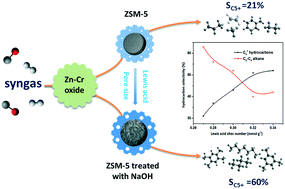The influence of alkali-treated zeolite on the oxide–zeolite syngas conversion process†
Abstract
The oxide–zeolite process has been attracting widespread attention due to its promising performance in syngas conversion to hydrocarbons with high selectivity and stability. Here, a composite catalyst containing Zn–Cr oxide and ZSM-5 zeolite provides a competitive option in the one-step conversion of syngas into C5+ hydrocarbons. In order to figure out the influence of the pore structure and acidity of zeolite on the oxide–zeolite process, alkali treatments on ZSM-5 are carried out. The treated ZSM-5 shows increased selectivity for gasoline fractions. With a set of structural and morphological characterization techniques, the formation of a hierarchical porous structure is demonstrated, which is favorable for the diffusion of heavy products. Furthermore, an increase in the number of Lewis acid sites, acting as the main active sites for the polymerization, cyclization and aromatization reactions, also contributes to the promotion of C5+ hydrocarbon production. It must be noted, however, that a certain amount of Brønsted acid sites is necessary for the tandem transformation of CH3OCH3 intermediates, which may further affect the CO conversion.



 Please wait while we load your content...
Please wait while we load your content...